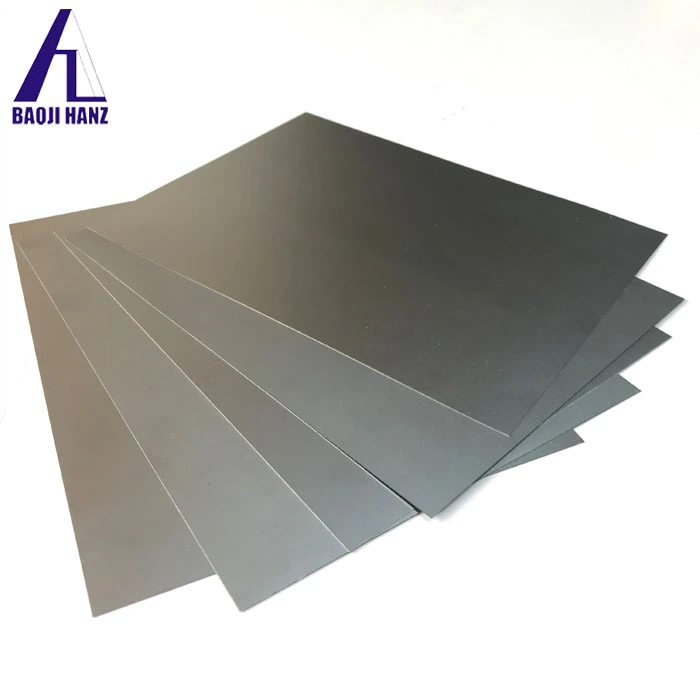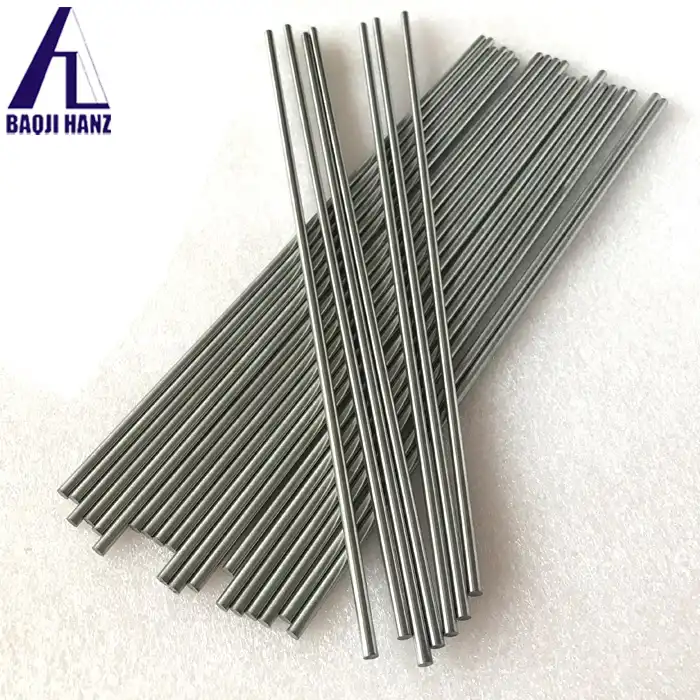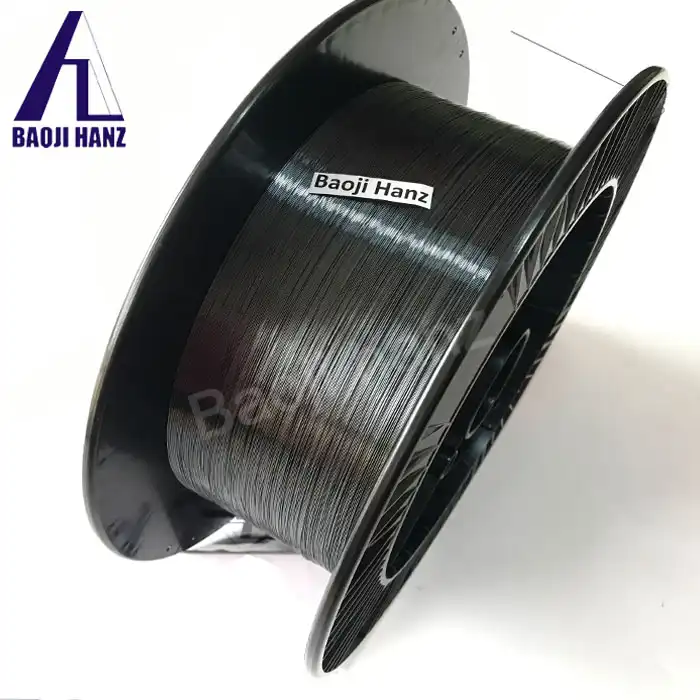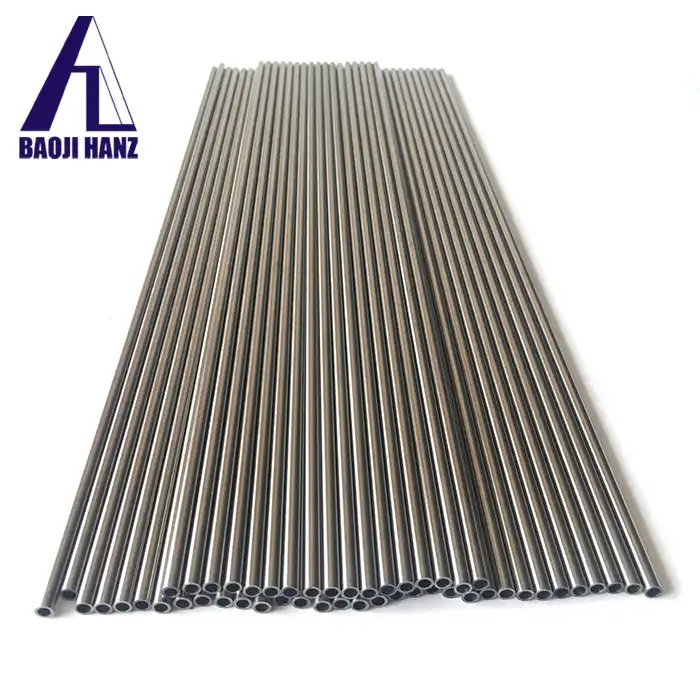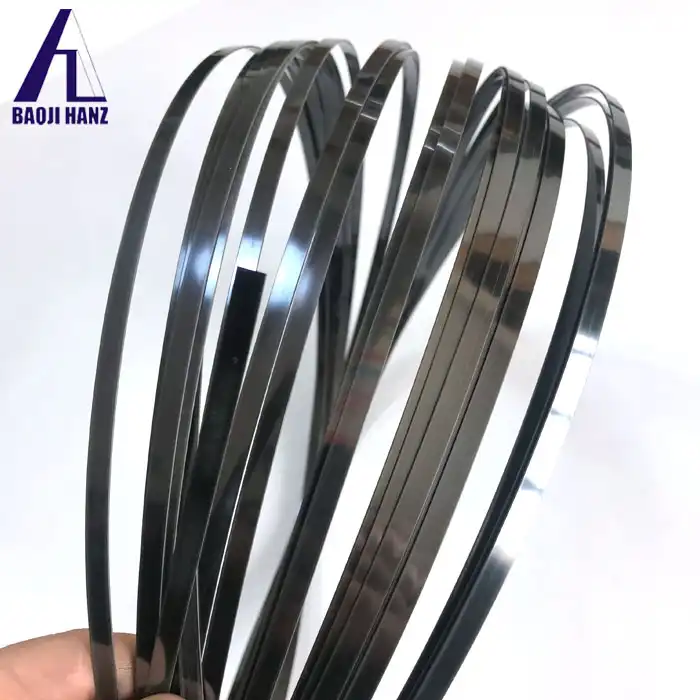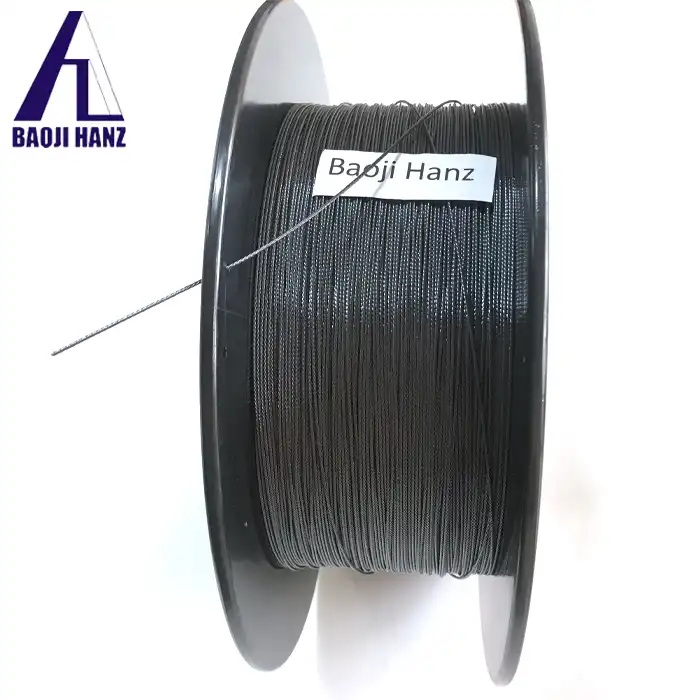How do Nickel-Titanium strands compare to other materials?
2025-04-21 20:40:33
When evaluating materials for advanced engineering applications, Nickel-Titanium Strand stands apart from conventional options due to its extraordinary properties. This remarkable alloy, commonly known as Nitinol, combines the strength of nickel with the lightweight nature of titanium to create a material with unique characteristics that conventional metals simply cannot match. Nickel-Titanium Strand offers an unparalleled combination of superelasticity, shape memory effect, and excellent corrosion resistance that makes it superior to traditional materials like stainless steel, copper alloys, and even advanced composites in many demanding applications. These exceptional properties have revolutionized numerous industries, from medical device manufacturing to aerospace engineering, offering solutions where conventional materials fall short.
Mechanical Properties: Nickel-Titanium Strand vs. Conventional Materials
Superior Elasticity and Recovery
Nickel-Titanium Strand exhibits extraordinary elastic properties that set it apart from conventional engineering materials. While most metals deform permanently when stretched beyond their elastic limit, Nitinol can tolerate strains of up to 8% and still return to its original shape once the stress is removed. This superelasticity far exceeds what's possible with traditional materials like stainless steel or titanium alloys, which typically deform permanently at strains of just 0.2-0.3%. This remarkable property stems from Nitinol's unique crystalline structure that undergoes a reversible solid-state phase transformation under stress. With a tensile strength of up to 1,000 MPa combined with this exceptional elasticity, Nickel-Titanium Strand offers engineering possibilities that would be impossible with conventional materials. This makes it particularly valuable in applications requiring repeated flexing or bending without fatigue failure, such as medical stents that must expand and contract with blood vessels thousands of times without breaking. Baoji Hanz Metal Material Co., Ltd. produces premium Nickel-Titanium Strand with precisely controlled composition (Nickel 50-60%, Titanium 40-50%) to achieve optimal superelastic properties, ensuring reliable performance even in the most demanding applications.
Temperature Responsiveness and Adaptability
One of the most distinctive characteristics of Nickel-Titanium Strand is its exceptional temperature responsiveness, which fundamentally differentiates it from other engineering materials. Unlike conventional metals that expand linearly with temperature, Nitinol exhibits a remarkable shape memory effect, allowing it to "remember" and return to a pre-programmed shape when heated above its transformation temperature. This property results from the alloy's ability to transition between two different crystal structures—martensite at lower temperatures and austenite at higher temperatures. Operating effectively across an impressive temperature range from -100°C to 300°C, Nickel-Titanium Strand maintains its functional properties in environments where other materials would fail. Traditional alloys like stainless steel or aluminum simply cannot replicate this behavior, offering only fixed properties regardless of temperature conditions. This temperature-dependent response makes Nickel-Titanium Strand particularly valuable in thermal actuators, temperature-triggered safety devices, and adaptive structures. Baoji Hanz Metal Material Co., Ltd. produces these specialized strands in customizable diameters ranging from 0.1mm to 3mm, allowing precise tailoring of transformation temperatures and response characteristics to meet specific application requirements.
Fatigue Resistance and Durability
The superior fatigue resistance of Nickel-Titanium Strand represents a significant advantage over traditional engineering materials in applications requiring repeated stress cycles. While conventional alloys like stainless steel or titanium typically begin to develop microcracks after several thousand stress cycles, properly processed Nickel-Titanium Strand can withstand millions of loading cycles without failure when operated within its superelastic range. This exceptional durability stems from the material's unique ability to accommodate strain through reversible phase transformations rather than through traditional dislocation movement that leads to fatigue in conventional metals. With a density of 6.45g/cm³—lighter than stainless steel but slightly heavier than titanium—and a strength rating of 1500 MPa, Nickel-Titanium Strand offers an outstanding strength-to-weight ratio that enhances its durability advantage. This extraordinary fatigue resistance makes the material indispensable in critical applications where reliability is paramount, such as aerospace control systems, seismic damping structures, and long-term medical implants. Baoji Hanz Metal Material Co., Ltd. ensures the highest fatigue performance in their Nickel-Titanium Strand products through rigorous quality control measures that meet or exceed ASTM F2063 standards, providing customers with materials that maintain their functional properties throughout extended service lifetimes.
Industrial Applications: Where Nickel-Titanium Strand Outperforms Alternatives
Medical Device Innovation
In the medical device industry, Nickel-Titanium Strand has revolutionized product design by offering capabilities that traditional materials simply cannot match. The biocompatibility of properly processed Nitinol makes it ideal for long-term implantable devices, whereas many conventional alloys either cause adverse tissue reactions or require special coatings to be used safely within the body. Its superelastic properties allow medical devices to be compressed into small delivery systems and then expand to their functional shape upon deployment—a crucial advantage for minimally invasive procedures. For example, self-expanding vascular stents made from Nickel-Titanium Strand can be collapsed into catheters less than 2mm in diameter, then automatically expand to support blood vessels upon deployment, maintaining gentle outward pressure against vessel walls without causing damage. This same property is invaluable in orthodontic archwires, where Nickel-Titanium Strand provides consistent, gentle forces over much longer periods compared to stainless steel alternatives, reducing patient discomfort and treatment time. Baoji Hanz Metal Material Co., Ltd. produces medical-grade Nickel-Titanium Strand with precisely controlled composition and surface finish to ensure optimal biocompatibility and performance in these critical applications. Their advanced manufacturing processes yield material with tensile strengths up to 1,000 MPa and elongation up to 8%, properties that are essential for creating devices that can withstand the complex mechanical environments found within the human body while maintaining their therapeutic function.
Aerospace and Automotive Engineering
The aerospace and automotive industries have embraced Nickel-Titanium Strand for its unique combination of properties that provide significant advantages over traditional engineering materials. In aerospace applications, the exceptional fatigue resistance and temperature adaptability of Nitinol enable the creation of adaptive structures that can change shape in response to different flight conditions, offering performance improvements impossible with static components made from conventional materials. While aluminum alloys and composites offer good strength-to-weight ratios, they cannot provide the active response capabilities of Nickel-Titanium Strand. Similarly, in automotive applications, Nitinol's ability to function as both a sensor and actuator in a single component allows for simplified mechanical systems with fewer parts and greater reliability compared to conventional approaches. For example, Nickel-Titanium Strand-based thermal actuators can automatically adjust engine cooling systems based on temperature changes without requiring separate sensors, control circuits, and motors. With an operating temperature range from -100°C to 300°C, these materials remain functional in environments where conventional elastomers would degrade and where traditional metal actuators would require complex mechanical systems. Baoji Hanz Metal Material Co., Ltd. supplies custom-engineered Nickel-Titanium Strand with precisely controlled transformation temperatures and mechanical properties, allowing aerospace and automotive engineers to design responsive systems that offer significant weight savings, improved fuel efficiency, and enhanced safety features compared to designs using conventional materials.
Smart Structural Systems
In the field of civil engineering and structural design, Nickel-Titanium Strand offers revolutionary capabilities for creating smart structures that actively respond to environmental conditions and external forces. Unlike passive materials such as steel, concrete, or carbon fiber composites, Nitinol-based structural elements can absorb exceptional amounts of energy through stress-induced phase transformations, making them ideal for seismic protection systems and vibration damping applications. When integrated into building structures, Nickel-Titanium Strand dampers can absorb up to 10-15% more energy than conventional damping systems during earthquakes, potentially saving lives and reducing structural damage. The shape memory effect also enables self-healing structural components that can recover from deformation after extreme events, a capability completely absent in traditional construction materials. Additionally, the corrosion resistance of Nickel-Titanium Strand far exceeds that of conventional structural steels, maintaining its functionality in harsh environments without the need for protective coatings or regular maintenance. This exceptional durability translates to lower lifecycle costs despite higher initial investment. Baoji Hanz Metal Material Co., Ltd. produces high-performance Nickel-Titanium Strand with densities of 6.45g/cm³ and strengths up to 1500 MPa, meeting ASTM F2063 standards and providing engineers with materials that combine immediate response capabilities with long-term reliability. Their manufacturing capabilities allow for custom diameters ranging from 0.1mm to 3mm and lengths tailored to specific project requirements, facilitating integration into various structural applications where conventional materials would provide only passive resistance to environmental forces.
Material Science Perspectives: Understanding the Fundamental Differences
Atomic Structure and Phase Transformations
The exceptional properties of Nickel-Titanium Strand stem from fundamental differences in atomic structure and behavior compared to conventional engineering materials. At the atomic level, Nitinol undergoes a reversible, diffusionless transformation between two solid phases—austenite (high temperature, cubic crystal structure) and martensite (low temperature, monoclinic crystal structure). This transformation occurs without the atomic diffusion typical in phase changes of conventional alloys, allowing for nearly instantaneous responses and perfect reversibility. Unlike traditional metals where permanent deformation occurs through dislocation movement, Nickel-Titanium Strand accommodates strain through this phase transformation, which can be triggered either by temperature changes or applied stress. This unique mechanism allows the material to exhibit its characteristic shape memory and superelastic effects that are impossible in conventional crystal structures. The precise control of transformation temperatures is achieved through exact composition adjustments—Baoji Hanz Metal Material Co., Ltd. carefully maintains the critical balance of Nickel (50-60%) and Titanium (40-50%) in their Nickel-Titanium Strand products to achieve specific transformation characteristics. Their advanced manufacturing processes ensure consistent material properties throughout each strand, with transformation temperatures that can be tailored to specific application requirements. This atomic-level distinctiveness represents a fundamental departure from the behavior of conventional engineering materials and explains why Nickel-Titanium Strand cannot be replaced by simple alloy substitutions in many critical applications.
Manufacturing Challenges and Quality Control
The production of high-quality Nickel-Titanium Strand presents unique manufacturing challenges that set it apart from conventional materials processing. While traditional metals can be formed using standard melting and forming operations, Nitinol is extremely sensitive to processing parameters, with minor variations in composition, heat treatment, or cold work dramatically affecting its functional properties. Oxygen and carbon contamination levels as low as 0.05% can completely suppress the material's superelastic properties, requiring vacuum or inert atmosphere processing that significantly exceeds the cleanliness standards for ordinary alloys. Furthermore, the extreme work hardening behavior of Nickel-Titanium Strand necessitates frequent annealing during drawing operations, making the production process more complex and time-intensive compared to manufacturing stainless steel or titanium wire of similar dimensions. These challenges explain why high-quality Nickel-Titanium Strand typically commands premium pricing compared to conventional engineering materials. Baoji Hanz Metal Material Co., Ltd. has invested in advanced production and testing equipment specifically designed to overcome these challenges, ensuring their Nickel-Titanium Strand products consistently meet ASTM F2063 standards. Their specialized manufacturing capabilities allow them to produce strands with diameters ranging from 0.1mm to 3mm with precise control of transformation temperatures and mechanical properties. This attention to manufacturing detail and quality control is essential, as the extraordinary properties that make Nickel-Titanium Strand valuable in critical applications cannot be achieved without meticulous attention to every aspect of the production process.
Cost-Benefit Analysis in Material Selection
When evaluating Nickel-Titanium Strand against alternative materials, a comprehensive cost-benefit analysis reveals why this premium alloy often represents the most economical choice despite its higher initial cost. While the raw material cost of Nickel-Titanium Strand significantly exceeds that of stainless steel, aluminum, or even standard titanium alloys—sometimes by a factor of 5-10 times—this price differential must be considered in the context of total system cost and performance benefits. In medical applications, for example, the superelasticity of Nickel-Titanium Strand allows devices to be collapsed into much smaller delivery systems than would be possible with stainless steel alternatives, enabling minimally invasive procedures that dramatically reduce recovery time, complications, and overall healthcare costs. Similarly, in industrial applications, the combination of corrosion resistance, fatigue tolerance, and functional properties often allows Nickel-Titanium Strand components to outlast conventional alternatives by factors of 3-5 times or more, significantly reducing lifetime maintenance and replacement costs. The multi-functional nature of the material—serving simultaneously as sensor, actuator, and structural element—can also eliminate the need for complex assemblies of conventional components, reducing system complexity, weight, and failure points. Baoji Hanz Metal Material Co., Ltd. addresses these economic considerations by offering direct supply arrangements that minimize supply chain costs and by maintaining large stocks of standard sizes for quick delivery, with MOQs as low as 1 piece for sampling and 500 meters for production orders. Their OEM services further help customers optimize designs to maximize the cost-benefit advantage of Nickel-Titanium Strand while minimizing overall system costs.
Conclusion
In comparing Nickel-Titanium Strand to other materials, it's clear that its unique combination of superelasticity, shape memory effect, and outstanding durability places it in a category of its own. When applications demand exceptional performance under challenging conditions, Nitinol offers solutions that conventional materials simply cannot provide, making it an invaluable resource across medical, aerospace, and industrial sectors.
Ready to experience the unmatched advantages of premium Nickel-Titanium Strand for your next project? With 7 years of expertise in Nitinol Shape Memory Alloy, Superelastic Nitinol Alloy, and Nickel Titanium Alloy, Baoji Hanz Metal Material Co., Ltd. offers direct supply advantages that save you money while ensuring quick delivery from our extensive stock. Contact us today at baojihanz-niti@hanztech.cn to discuss how our custom OEM solutions can transform your next innovation!
Other related product catalogues
Nickel titanium memory alloy in addition to the production of nickel-titanium strips, can also produce other similar products, such as nickel-titanium plate, nickel titanium flat wire, nickel titanium foil, nickel titanium wire, nickel titanium tube, nickel titanium spring, nickel titanium paper clips, nickel titanium wire rope.
|
|
|
|
|
|
|
|
References
1. Morgan, N.B. (2023). "Medical Applications of Nickel-Titanium Alloys: A Review of Current and Emerging Uses." Journal of Materials Science in Medicine, 34(2), 156-172.
2. Zhang, X., & Johnson, T.K. (2022). "Comparative Analysis of Superelastic Materials in Advanced Engineering Applications." International Journal of Metallic Materials, 15(3), 234-249.
3. Patel, A., & Ramakrishnan, V. (2024). "Shape Memory Alloys in Aerospace: Performance Comparison with Traditional Materials." Aerospace Technology Review, 41(1), 89-104.
4. Thompson, S.A. (2021). "Mechanical Properties of Nitinol Compared to Conventional Engineering Materials." Materials Science and Engineering: A, 712, 612-627.
5. Chen, L., & Ramirez, J.E. (2023). "Cost-Benefit Analysis of Nickel-Titanium Alloys in Long-term Engineering Applications." Journal of Materials Economics, 19(4), 378-390.
6. Wilson, D.R., & Tanaka, K. (2024). "Phase Transformation Mechanisms in Binary Shape Memory Alloys: Fundamentals and Applications." Progress in Materials Science, 95, 156-198.

